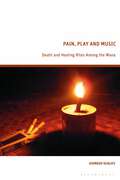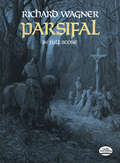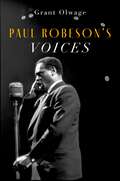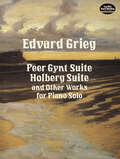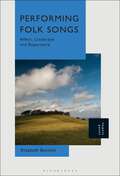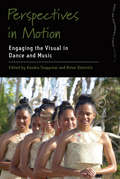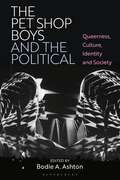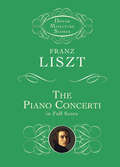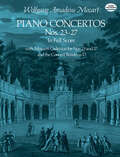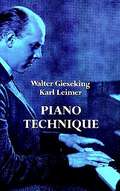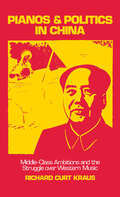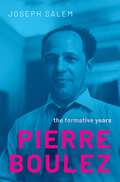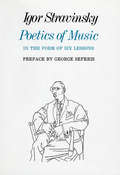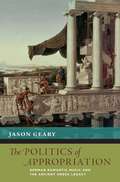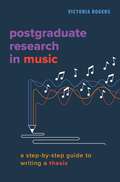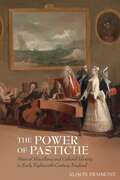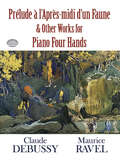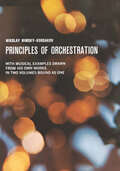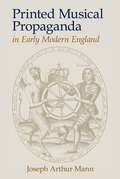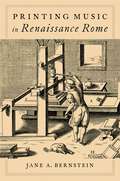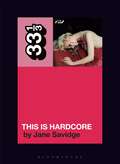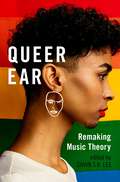- Table View
- List View
Pain, Play and Music: Death and Healing Rites Among the Wana
by Giorgio ScaliciThe Wana people of Morowali accept the experiences of pain, illness and loss and transform them into something positive: rituals that celebrate life, friendship and the community. Through fieldwork with the Wana people of Morowali, Central Sulawesi, Giorgio Scalici shows how music serves as a connection between the human world and the hidden world of spirits and emotion.By examining rituals such as the momago, the main Wana healing ritual, and the kayori, the funeral, this book investigates how music is used by the Wana to heal people, control emotions, reinforce the sense of community and to mark the cultural death of the community member. In this study, music transforms the pain of loss into a playful event that heals the community and assures its future.This book will be of interest to the wider academic study of religion, anthropology and ethnomusicology as it looks as at funerals as healing rituals for the community which lead the living and the dead through critical times.
Parsifal in Full Score
by Richard WagnerCompleted in 1882, Parsifal is Wagner's last opera and one of his finest, renowned for its splendid music and glowing orchestration. With its deeply personal treatment of the legend of the Holy Grail, and the subtle intensity and depth of compassion of its treatment of themes of innocence and purity, remorse and sexual renunciation, the opera ranks as one of Wagner's most symbolic, intense, and compassionate works.This Dover edition reproduces every note of this glorious masterpiece from the authoritative C. F. Peters edition, including the list of characters and contents in both German and English. It will be welcomed by musicians, music lovers, opera buffs, and admirers of Wagner as the only complete, inexpensive edition of a 19th-century landmark.
Paul Robeson's Voices
by Grant OlwagePaul Robeson's Voices is a meditation on Robeson's singing, a study of the artist's life in song. Music historian Grant Olwage examines Robeson's voice as it exists in two broad and intersecting domains: as sound object and sounding gesture, specifically how it was fashioned in the contexts of singing practices, in recital, concert, and recorded performance, and as subject of identification. Olwage asks: how does the voice encapsulate modes of subjectivity, of being? Combining deep archival research with musicological theory, this book is a study of voice as central to Robeson's sense of self and his politics. Paul Robeson's Voices charts the dialectal process of Robeson's vocal and self-discovery, documenting some of the ways Robeson's practice revised the traditions of concert singing in the first half of the twentieth century and how his voice manifested as resistance.
Peer Gynt Suite, Holberg Suite, and Other Works for Piano Solo
by Edvard GriegTreasury of piano music by great Norwegian composer, including the perennial favorites, Peer Gynt Suites Nos. 1 and 2 and the Holberg Suite, as well as a rich selection of other pieces: Vier Stucke, Op. 1, Humoresker, Op. 6, Sonata in E Minor, Op. 7, Zwei elegische Melodien, Op. 34, Stimmungen, Op. 73 and many others. Authoritative C. F. Peters edition.
Performing Folk Songs: Affect, Landscape and Repertoire
by Dr. Elizabeth BennettPerforming Folk Songs is the first full-length volume to explore English folk singing from the perspective of performance studies. Using archival sources, family repertoire and recorded performances of interviewees, this book argues that archives and repertoires are produced in sensory environments and through embodied encounters. Autoethnography, sensory ethnography, life-writing and landscape writing are used to explore the affective and emotional aspects of learning songs 'by heart'. Drawing on her experience as a folk singer, Bennett contributes to discourse on English folk traditions in the 21st century and brings performance scholarship to the contemporary folk song resurgence. In analyzing the performance of English folk songs in the affective context of the archive and the landscape, the book engages with and contributes original insights to scholarship on folk music, performance studies, affect theory, cultural geography and intangible cultural heritage studies.
Perspectives in Motion: Engaging the Visual in Dance and Music (Dance and Performance Studies #15)
by Kendra Stepputat Brian DiettrichFocusing on visual approaches to performance in global cultural contexts, Perspectives in Motion explores the work of Adrienne L. Kaeppler, a pioneering researcher who has made a number of interdisciplinary contributions over five decades to dance and performance studies. Through a diverse range of case studies from Oceania, Asia, and Europe, and interdisciplinary approaches, this edited collection offers new critical and ethnographic frameworks for understanding and experiencing practices of music and dance across the globe.
The Pet Shop Boys and the Political: Queerness, Culture, Identity and Society
The Pet Shop Boys came of age at a time of deep socio-political tension. From the rise of sexual politics and awareness to Thatcherite neoliberalism and the Cold War, this book explores the cultural and political impact of the band and offers a fascinating window into the late 20th and early 21st centuries. An archetypal 'gay band', it shows how their overt queerness influenced generations of LGBTQIA+ music lovers and artists alike. Covering the full oeuvre of The Pet Shop boys; their albums, films, stage productions and collaborations, chapters in this collection show how their work is suffused with political commentary on the past and present covering themes as broad as queer identity, the HIV/AIDs epidemic, globalization and Brexit. It also places them within the context of their times and considers them as activists, authors, social commentators, political actors and personalities to better understand what influenced them. Bringing together a range of perspectives and disciplines, The Pet Shop Boys and the Political provides a unique and untapped insight into a formative pop band of the modern era that has mirrored and shaped society over the past forty years.
The Piano Concerti
by Franz LisztOne of the greatest piano virtuosos of all time, Franz Liszt composed piano music marked by its technical brilliance, innovation, and imagination. This collection presents authoritative miniature score editions of two staples of the repertoire: Liszt's Piano Concerto No. 1 in E-flat Major and his Piano Concerto No. 2 in A Major.The works are reproduced here from authoritative editions, complete with bar-numbered movements for easy reference. Affordable, durable, and portable, this miniature score edition is ideal for study in the classroom, at home, or in the concert hall.
Piano Concertos: Nos. 23-27 in Full Score
by Wolfgang Amadeus MozartThis volume contains Mozart's last five piano concertos: No. 23 in A Major, K488; No. 24 in C Minor, K491; No. 25 in C Major, K503; No. 26 in D Major, K537; and No. 27 in B-flat Major, K595. As a bonus in the piano-plus-orchestra genre, the brief Concert Rondo in D Major, K382, has been added along with Mozart's own cadenzas for Nos. 23 and 27.The music is photographically reprinted from the Breitkopf & Härtel text, still considered the standard, authoritative edition for the Mozart concertos. Noteheads in this edition are large enough to be read easily, and margins and spaces between staves permit written notes, harmonic analysis, fingerings, and running measure numbers.Since Mozart's piano concertos are frequently performed in concert and there are several recordings currently available for each of these pieces, this edition is extremely useful for study, reference, and enjoyment.
Piano Technique
by Walter Gieseking Karl LeimerThe volume presents two book by Walter Gieseking, foremost pianist of his generation, and his teacher for five years, Karl Leimer, that have long been sought after by students and teachers looking for a radical approach toward developing not only finger-technique but expression-technique. Emphasis throughout is on listening to one's self and proper understanding as the basis of proper technique for the piano.In book one, originally titled The Shortest Way to Pianistic Perfection, Gieseking and Leimer work with a series of piano works -- a study from Lebert and Stark, Bach's Two- and Three-Part Inventions in C, and Beethoven's Sonata in F Minor, Op. 2, No. 1. Before beginning to play, the student is asked to visualize each piece through silent reading. Through Leimer's instruction in this area the student soon discovers how to approach each piece as not merely a series of notes to memorize but as a coherent musical structure to understand. Following are instructions on natural interpretation, with consideration of touch, relaxation, and proper emphasis in the practice. Also given are notes on such topics as etudes, scales, broken chords, the trill, and tranquility.In book two, Rhythmics, Dynamics, Pedal and Other Problems of Piano Playing, Leimer carries his method of visualization further with a study of the Allemande from Bach's French Suite in E Major. Following are further exercises and practices for developing other pianistic technique with reference to works of other composers. Specific exercises which cover rhythmics, dynamics, and phrasing are designed so that they will benefit not only the pianist but also performers on other instruments. Extensive chapters on variety of touch and the pedal give a great number of techniques and exercises for extending the expressive and dynamic range.
Pianos And Politics In China: Middle-class Ambitions And The Struggle Over Western Music
by Richard Curt KrausIn China, a nation where the worlds of politics and art are closely linked, Western classical music was considered during the cultural revolution to be an imperialist intrusion, in direct conflict with the native aesthetic. In this revealing chronicle of the relationship between music and politics in twentieth-century China, Richard Kraus examines the evolution of China's ever-changing disposition towards European music and demonstrates the steady westernization of Chinese music. Placing China's cultural conflicts in global perspective, he traces the lives of four Chinese musicians and reflects on how their experiences are indicative of China's place at the furthest edge of an expanding Western international order.
Pierre Boulez: The Formative Years
by Joseph SalemAs an integral figure in twentieth-century music, Pierre Boulez innovated new musical ideas through extraordinary creative processes. His formative years tracked his compositional development from his confrontations with serialism to drafting one of his major works, Pli selon pli, in the early 1960s. Part biography, part survey, Pierre Boulez: The Formative Years situates Boulez and his compositions among a complex network of influences. To best understand Boulez's creative process, author Joseph R. Salem organizes the book into three parts. First, Boulez's early life, training, and education provide biographical context for his career. Salem provides a fresh, revisionist perspective of the composer's life by drawing upon a mix of primary and secondary sources. Second, the brunt of the biography situates Boulez's musical works and experimentation among a host of contextual contexts. In place of scores and complicated musical analyses, Salem employs sketches as a visual metonym. The sketches denote Boulez's continual ability to self-reform, accept feedback from his peers, mentors, and family members, and revitalize old material. Third, Boulez's legacy is associated with contemporaneous aesthetic movements and artistic challenges. While his creative processes undoubtedly influenced music today, Boulez remains a controversial, even taboo, figure among contemporary musicians and audiences. A book that both celebrates and critiques its subject, The Formative Years urges a reconsideration of narratives and discussions surrounding Boulez's life and works.
Plan of an Orchestra layout (UEB Contracted)
This is a labelled plan (seen from above) of a classical orchestra, showing where the various instrumentalists and the conductor are placed on the concert platform. There is a locator dot shown, which will be at the top left of the page when the image is the right way up. The conductor is in the bottom centre of the page; he is the performer who is nearest the audience and stands with his back to them, facing the rest of the players further up the page. The various areas occupied by the instruments are labelled. The stringed instruments occupy the bottom third of the page with the woodwind and brass instruments further up the page. The percussion instruments are at the top left of the page.
Plan of an Orchestra layout (UEB Uncontracted)
This is a labelled plan (seen from above) of a classical orchestra, showing where the various instrumentalists and the conductor are placed on the concert platform. There is a locator dot shown, which will be at the top left of the page when the image is the right way up. The conductor is in the bottom centre of the page; he is the performer who is nearest the audience and stands with his back to them, facing the rest of the players further up the page. The various areas occupied by the instruments are labelled. The stringed instruments occupy the bottom third of the page with the woodwind and brass instruments further up the page. The percussion instruments are at the top left of the page.
Poetics of Music in the Form of Six Lessons (Charles Eliot Norton Lectures (hup) Ser. #2003)
by Igor StravinskyOne of the greatest of contemporary composers has here set down in delightfully personal fashion his general ideas about music and some accounts of his own experience as a composer. Every concert-goer and lover of music will take keen pleasure in his notes about the essential features of music, the process of musical composition, inspiration, musical types, and musical execution. Throughout the volume are to he found trenchant comments on such subjects as Wagnerism, the operas of Verdi, musical taste, musical snobbery, the influence of political ideas on Russian music under the Soviets, musical improvisation as opposed to musical construction, the nature of melody, and the function of the critic of music. Musical people of every sort will welcome this first presentation in English of an unusually interesting book.
Postgraduate Research in Music: A Step-by-Step Guide to Writing a Thesis
by Victoria RogersPostgraduate Research in Music: A Step-by-Step Guide to Writing a Thesis is an essential text for music students who are undertaking postgraduate research. Unique in its approach and scope, this is a "how to" book, a practical guide that sets out, step-by-step, how to write a thesis. It discusses all key aspects of the research process in the order in which they are encountered, from the initial stages of a research project to completion of a thesis. It also offers a music-specific focus, with explanations and examples that are immediately relevant for all music research and which take into account the special characteristics of music as a discipline. At the same time, the book provides a useful teaching framework for lecturers. All key concepts are illustrated with music-relevant examples. Exercises, and in some chapters class seminar topics as well, are included to reinforce the concepts being discussed. Reading lists are appended at the end of most chapters, enabling students to explore topics in greater depth. Valuable supplementary information, such as referencing examples, is provided in the appendices. Postgraduate Research in Music is based on the premise that there are certain principles that underpin good scholarship, regardless of the area in which the research is conducted. In distilling and discussing these principles, this book speaks to all scholars working within the discipline of music.
The Power of Pastiche: Musical Miscellany and Cultural Identity in Early Eighteenth-Century England (Clemson University Press: Studies in British Musical Cultures)
by Alison DeSimoneIn eighteenth-century England, “variety” became a prized aesthetic in musical culture. Not only was variety—of counterpoint, harmony, melody, and orchestration—expected for good composition, but it also manifested in cultural mediums such as songbook anthologies, which compiled miscellaneous songs and styles in single volumes; pasticcio operas, which were cobbled together from excerpts from other operas; and public concerts, which offered a hodgepodge assortment of different types and styles of performance. I call this trend of producing music through the collection, assemblage, and juxtaposition of various smaller pieces as musical miscellany; like a jigsaw puzzle (also invented in the eighteenth century), the urge to construct a whole out of smaller, different parts reflected a growing desire to appeal to a quickly diversifying England. This book explores the phenomenon of musical miscellany in early eighteenth-century England both in performance culture and as an aesthetic. Chapters offer analyses of concert programming, early music criticism, the compilation of pasticcio operas and songbook miscellanies, and even the ways in which composers and performers shaped their freelancing careers. Musical miscellany, in its many forms, juxtaposed foreign and homegrown musical practices and styles in order to stimulate discourse surrounding English musical culture during a time of cosmopolitan transformation as the eighteenth century unfolded.
Prelude a l'Apres-midi d'un Faune and Other Works for Piano Four Hands
by Maurice Ravel Claude DebussyHere are two suites Debussy composed specifically for piano four hands, Petite Suite and Six Épigraphes Antiques, plus Ravel's arrangement for four hands of Debussy's Prélude à l'Après-midi d'un Faune and a piano four hands version of Prélude, Cortège and Air de Danse from L'Enfant Prodigue. These works range widely in mood, displaying both the brilliant pianism at the heart of Debussy's musical imagery and the composer's affinity for the unexpected. Reprinted from authoritative French editions, these works display innovative musical qualities that will both delight and challenge pianists.
Principles of Orchestration
by Nikolai Rimsky-Korsakov"To orchestrate is to create, and this cannot be taught," wrote Nikolay Rimsky-Korsakov, the great Russian composer whose genius for brilliant, highly colored orchestration is unsurpassed. But invention, in all art, is closely allied to technique, and technique can be taught. This book, therefore, which differs from most other texts on the subject because of its tremendous wealth of musical examples and its systematic arrangement of material according to each constituent of the orchestra, will undoubtedly be of value to any music student. It is a music classic, perhaps the only book on classical orchestration written by a major composer.In it, the composer aims to provide the reader with the fundamental principles of modern orchestration from the standpoint of brilliance and imagination, and he devotes considerable space to the study of tonal resonance and orchestral combination. In his course, he demonstrates such things as how to produce a good-sounding chord of certain tone-quality, uniformly distributed; how to detach a melody from its harmonic setting; correct progression of parts; and other similar problems.The first chapter is a general review of orchestral groups, with an instrument-by-instrument breakdown and material on such technical questions as fingering, range, emission of sound, etc. There follows two chapters on melody and harmony in strings, winds, brasses, and combined groups. Chapter IV, Composition of the Orchestra, covers different ways of orchestrating the same music; effects that can be achieved with full tutti; tutti in winds, tutti pizzicato, soli in the strings, etc.; chords; progressions; and so on. The last two chapters deal with opera and include discussion of solo and choral accompaniment, instruments on stage or in the wings, technical terms, soloists (range, register, vocalization, vowels, etc.), voices in combination, and choral singing. Immediately following this text are some 330 pages of musical examples drawn from "Sheherazade," the "Antar Symphony," "Capriccio Espagnol," "Sadko," "Ivan the Terrible," "Le Coq d'Or," "Mlada," "The Tsar's Bride," and others of Rimsky-Korsakov's works. These excerpts are all referred to in the text itself, where they illustrate, far better than words, particular points of theory and actual musical practice. They are largely responsible for making this book the very special (and very useful) publication it is.This single-volume edition also includes a brief preface by the editor and extracts from Rimsky-Korsakov's 1891 draft and final versions of his own preface, as well as an appendixed chart of single tutti chords in the composer's works.
Printed Musical Propaganda in Early Modern England (Clemson University Press: Studies in British Musical Cultures)
by Joseph MannPrinted Musical Propaganda in Early Modern England reveals how consistently music, in theory and practice, was used as propaganda in a variety of printed genres that included or discussed music from the English Civil Wars through the reign of William and Mary. These printed items—bawdy broadside ballads, pamphlets paid for by Parliament, sermons advertising the Church of England’s love of music, catch-all music collections, music treatises addressed to monarchs, and masque and opera texts—when connected in a contextual mosaic, reveal a new picture of not just individual propaganda pieces, but multi-work propaganda campaigns with contributions that cross social boundaries. Musicians, Royalists, Parliamentarians, government officials, propagandists, clergymen, academics, and music printers worked together setting musical traps to catch the hearts and minds of their audiences and readers. Printed Musical Propaganda proves that the influential power of music was not merely an academic matter for the early modern English, but rather a practical benefit that many sought to exploit for their own gain.
Printing Music in Renaissance Rome
by Jane A. BernsteinIn sixteenth-century Italy, Rome ranked second only to Venice as an important center for music book production. Throughout the century, printers in the Eternal City experimented more readily and more consistently with the materiality of the book than their Venetian counterparts, who, by standardizing their printing methods, came to dominate the international marketplace. The Romans' ingenuity and willingness to meet individual clients' needs resulted in music editions in a broader array of shapes and sizes, employing a wider range of printing techniques. They became "boutique" printers, eschewing the run-of-the-mill in favor of tailoring production to varied market demands. Accommodating the diverse requirements of their clientele, they supplied customized volumes, which Venetian presses either could not--or would not--produce. In Printing Music in Renaissance Rome, author Jane A. Bernstein offers a panoramic view of the cultures of music and the book in Rome from the beginning of printing in 1476 through the early seventeenth century. Emphasizing the exceptionalism of Roman music publishing, she highlights the innovative printing technologies and book forms devised by Roman bookmen. She also analyzes the Church's predominant influence on the book industry and, in turn, the Roman press's impact on such important composers as Palestrina, Marenzio, Victoria, and Cavalieri. Drawing on innovative publications, Bernstein reveals a synergistic relationship between music repertories and the materiality of the book. In particular, she focuses on the post-Tridentine period, when musical idioms, both new and old, challenged printers to employ alternative printing methods and modes of book presentation in the creation of their music editions. Of interest to musicologists, art historians, and book historians alike, this book builds on Bernstein's previous work as she continues to chart the course of music and the book in Renaissance Italy.
Pulp's This Is Hardcore (33 1/3)
by Jane SavidgeThis Is Hardcore is Pulp's cry for help. A giant, sprawling, flawed masterpiece of a record, the 1998 album manages to tackle some of the most inappropriate grown-up issues of the day – fame, ageing, mortality, drugs, and pornography – and still come out crying and laughing on the other side. The subject of pornography dominates the record – from its controversial artwork to the images conjured up by songs like "Seductive Barry" and the title track – after Pulp's main man, Jarvis Cocker – who'd spent most of his teenage and adult life chasing celebrity, only to be cruelly disappointed when it finally arrived in spades – hit upon the grand notion of using pornography as a metaphor for fame. The album's commercial failure as a follow-up to the band's Britpop-defining, Different Class, also symbolizes a death knell for Britpop itself. Dark, right? Except just like Pulp themselves, Jane Savidge's book is playful and sometimes very funny indeed. Kicking off with an imaginary conversation between Jarvis Cocker and the people who run the Total Fame Solutions helpline, Savidge expertly guides us through the trials and tribulations of an album that begins with the so-called Michael Jackson Incident, when Cocker got up on stage at the 1996 Brit Awards and waggled his fully-clothed bum at the King of Pop. Pulp's This Is Hardcore may be a sleazy run through porn and mental demise, and an album that chronicles Cocker's continuing disillusionment with his newfound lot in life, but Savidge's book assesses the cultural and historical context of the album with insider knowledge and a sharp modern lens, ultimately making a case for it as one of the most important albums of the 1990s.
Queer Ear: Remaking Music Theory
Through provisional, idiosyncratic, and non-normative listening practices, Queer Ear: Remaking Music Theory counters music theory's continuing tendencies towards rationality, unity, unilinearity, teleology, and logical certainty. In this volume, editor Gavin S.K. Lee brings together a diverse group of music theorists who issue queer challenges to both music theory and musicology and show that queerness is integral to music-theoretical practice. These investigations of the "queer ear" and queer soundings, while drawing upon a broad range of approaches, are united by the repurposing of "hard" music-theoretical apparatuses, as well as "soft" apparatuses like narratology and cultural theory, for queer ends. Such repurposings contribute to the search for general principles--or a theory--of queering that counters mainstream music theory's proclivities, instead encouraging everyone to experiment with queer ways of listening. Through the lenses of queer temporality, queer narratology, and queer music analysis, the essays examine a wide variety of artists and composers, including Sun Ra, Cowell, Czernowin, Henze, Schubert, and Schumann; theories ranging from Schenker to queer shame, disability studies, and posthumanism; and authors such as Edward Cone and Edward Prime-Stevenson. Together, they rethink the field's major tenets, examine hidden histories, and view listening practices from the perspective of non-normative subjectivities. Ultimately, Queer Ear works to queer the field of music theory while paying heed to the ways in which music theory intersects with diverse, embodied LGBTQ lives.
The Reminiscences and Selected Criticism of Herbert Thompson (Clemson University Press w/ LUP)
Herbert Thompson (1856-1945) was chief music critic at The Yorkshire Post from 1886 until 1936, as well as being the Yorkshire correspondent for the Musical Times. This volume includes a critical edition of his Reminiscences, and a substantial selection of his published music criticism. Thompson offers a fascinating commentary on the nature of music criticism and the value of programme notes, along with his views on a plethora of composers (including J. S. Bach, Brahms, Mendelssohn, Meyerbeer, Stanford, Sullivan, and Wagner), performers (such as Leonard Borwick, Joachim, Clara Schumann, and Sivori, plus a range of operatic and concert vocalists), and conductors (Buths, Costa, Nikisch, Richter, von Bülow, amongst others). In addition to charting his concert-going in London (with reference to institutions such as the Philharmonic Society, the Bach Choir and the Crystal Palace concerts) and documenting a range of performance timings, Thompson also discusses programming at provincial festivals (including Bridlington, Gloucester and Hovingham, but especially Leeds) and the variety of music-making in Yorkshire. Not only does Thompson highlight the rich detail of British musical life, but his description of his musical tour of Europe in 1889 represents a significant contribution to nineteenth-century travel writing and the nature of music-making abroad.
